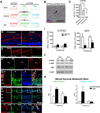Cytochrome P450 2C8 ω3-long-chain polyunsaturated fatty acid metabolites increase mouse retinal pathologic neovascularization--brief report
- PMID: 24458713
- PMCID: PMC4005334
- DOI: 10.1161/ATVBAHA.113.302927
Cytochrome P450 2C8 ω3-long-chain polyunsaturated fatty acid metabolites increase mouse retinal pathologic neovascularization--brief report
Abstract
Objective: Regulation of angiogenesis is critical for many diseases. Specifically, pathological retinal neovascularization, a major cause of blindness, is suppressed with dietary ω3-long-chain polyunsaturated fatty acids (ω3LCPUFAs) through antiangiogenic metabolites of cyclooxygenase and lipoxygenase. Cytochrome P450 epoxygenases (CYP2C8) also metabolize LCPUFAs, producing bioactive epoxides, which are inactivated by soluble epoxide hydrolase (sEH) to transdihydrodiols. The effect of these enzymes and their metabolites on neovascularization is unknown.
Approach and results: The mouse model of oxygen-induced retinopathy was used to investigate retinal neovascularization. We found that CYP2C (localized in wild-type monocytes/macrophages) is upregulated in oxygen-induced retinopathy, whereas sEH is suppressed, resulting in an increased retinal epoxide:diol ratio. With a ω3LCPUFA-enriched diet, retinal neovascularization increases in Tie2-driven human-CYP2C8-overexpressing mice (Tie2-CYP2C8-Tg), associated with increased plasma 19,20-epoxydocosapentaenoic acid and retinal epoxide:diol ratio. 19,20-Epoxydocosapentaenoic acids and the epoxide:diol ratio are decreased with overexpression of sEH (Tie2-sEH-Tg). Overexpression of CYP2C8 or sEH in mice does not change normal retinal vascular development compared with their wild-type littermate controls. The proangiogenic role in retina of CYP2C8 with both ω3LCPUFA and ω6LCPUFA and antiangiogenic role of sEH in ω3LCPUFA metabolism were corroborated in aortic ring assays.
Conclusions: Our results suggest that CYP2C ω3LCPUFA metabolites promote retinal pathological angiogenesis. CYP2C8 is part of a novel lipid metabolic pathway influencing retinal neovascularization.
Keywords: angiogenesis factor; cytochrome P450 CYP2C8 (human); pathologic neovascularization.
Figures


References
-
- Friedman DS, O’Colmain BJ, Muñoz B, Tomany SC, McCarty C, de Jong PT, Nemesure B, Mitchell P, Kempen J. Eye Diseases Prevalence Research Group. Prevalence of age-related macular degeneration in the United States. Arch Ophthalmol. 2004;122:564–572. - PubMed
-
- Kempen JH, O’Colmain BJ, Leske MC, Haffner SM, Klein R, Moss SE, Taylor HR, Hamman RF. Eye Diseases Prevalence Research Group. The prevalence of diabetic retinopathy among adults in the United States. Arch Ophthalmol. 2004;122:552–563. - PubMed
Publication types
MeSH terms
Substances
Grants and funding
LinkOut - more resources
Full Text Sources
Other Literature Sources
Molecular Biology Databases
Miscellaneous

